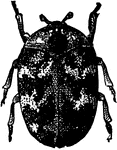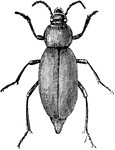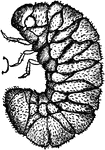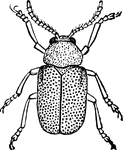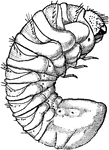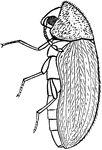This ClipArt gallery includes 561 illustrations of insects from the order Coleoptera, including beetles, weevils, borers, carabus, scarabs, and ladybugs (also known as ladybirds or lady beetles).
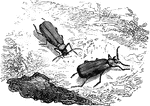
Cardinal Beetle
"One of the most beautiful of the European species of trachelia is the Pyrochroa rubens, which…

Carrion Beetle
"Carrion-beetle (Silpha inaequalis). a, larva; d, same; f, g, h, mandible, labium, and maxilla of larva;…

Caterpillar Hunter Beetles
Beetles form a large group of insects that number over 300,000 species. They all have hard wings which…

Cetonia Argentea
"These insects often feed upon matter in a state of putrefaction. They are nature's undertakers. A great…

Churchyard Beetle
"These insects are generally found in dark and dirty places about houses, in cellars, and similar situations."…

Cigarette Beetle
"The cigarette beetle: a, larva; b, pupa; c, adult; d, side view of adult; e, antenna." -Department…

Click Beetle
"The Elater striatus of Caenne, is an inch long, of a black color, and striped upon the back."…

Click Beetle
A type of beetle that when placed on it back, will spring up in the air onto its feet, producing a clicking…
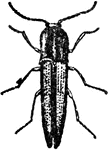
Click Beetle
"Springing Beetles, Elateridae, are narrower and more elongate than the former, and their legs are so…

Click Beetle
The family Elateridae is commony called click beetles (or "typical click beetles" to distinguish them…
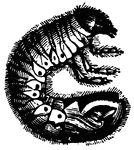
Larva of the Cockchafer (Melolontha Vulgaris)
"In from four to six weeks after being laid, the little larvae are hatched, and immediately attack the…

Larva of the Cockchafer (Melolontha Vulgaris)
"In from four to six weeks after being laid, the little larvae are hatched, and immediately attack the…

Pupa of the Cockchafer (Melolontha Vulgaris)
"At the end of the third year it changes into a pupa, after having surrounded itself with a cocoon consolidated…

Pupa of the Cockchafer (Melolontha Vulgaris)
"At the end of the third year it changes into a pupa, after having surrounded itself with a cocoon consolidated…
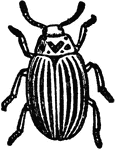
Colorado Beetle
"The Colorado Beetle is a beetle first described by Thomas Say, in 1824, from specimens found by him…
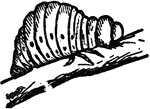
Colorado Beetle Larva
"The Colorado Beetle is a beetle first described by Thomas Say, in 1824, from specimens found by him…
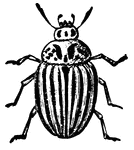
Colorado Potato Beetle
The Colorado potato beetle (Leptinotarsa decemlineata), also known as the Colorado beetle, ten-striped…
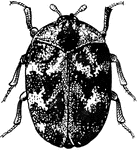
Adult Common Carpet Beetle
An adult common carpet beetle, a small grayish or black beetle belonging to the order Coleoptera.

Common Carpet Beetle Larva
Larva of the common carpet beetle, a small grayish or black beetle belonging to the order Coleoptera.

Common Carpet Beetle Larva
Larva of the common carpet beetle, a small grayish or black beetle belonging to the order Coleoptera.

Common Carpet Beetle Pupa
Pupa of the common carpet beetle, a small grayish or black beetle belonging to the order Coleoptera.

Corn Beetle
"Corn Beetle: a, larva, natural size; b, larva, magnified; c, perfect insect, natural dize; d, perfect…

Ctenostoma Rugosa
"According to a traveler, the women of Egypt eat these cooked with butter to make them fat. They are…
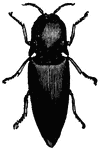
Cucuyo (Pyrophorus Noctilucus)
"An insect very common in Havana, Brazil, Guiana and Mexico. It may be seen at night in great numbers…
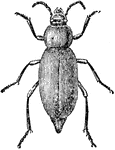
Darkling Beetle
Darkling beetles (also known as Darkening beetles) are a family of beetles found worldwide, estimated…

Deathwatch Beetles
"Other species, which also bore into timber in their larva state, are well known by the name of Death-watch…

Diamond Beetle
"Even among the small species several of great beauty are to be met with, and few insects can boast…
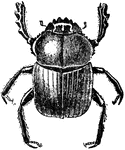
Dung Beetle
"A black insect, with brilliant metallic blue or purple reflections on the under side, and well known…

Dung Beetle
"A black insect, with brilliant metallic blue or purple reflections on the under side, and well known…
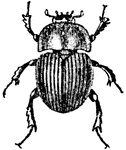
Dung Beetle
"A black insect, with brilliant metallic blue or purple reflections on the under side, and well known…

Dung Beetle
The dung beetle is an insect in the Scarabaeidae family and was a sacred icon to the Egyptians.
!["They introduce themselves under the skin of the carcasses of animals, and devour their flesh to the bone. [This] species climbs trees and attacks caterpillars."](https://etc.usf.edu/clipart/53400/53403/53403_silpha_quadr_mth.gif)
Dung Beetle (Silpha Quadrapunctata)
"They introduce themselves under the skin of the carcasses of animals, and devour their flesh to the…
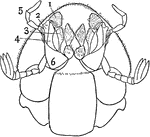
Ventral View of Dung Beetle
"Under Surface of Head of Tumble-bug (Copris carolina), about four times natural size. 1, galea; 2,…

Dynastes Hercules
"The Ateuchi are large, flat insects, with a broudtoothed clypeus. To this genus belongs the…

Dyticus Marginalis (Female)
"The most common species of the Dytici, or Water Beetles. They sometimes attack the Hydrophilus…

Dyticus Marginalis (Male)
"The most common species of the Dytici, or Water Beetles. They sometimes attack the Hydrophilus…

